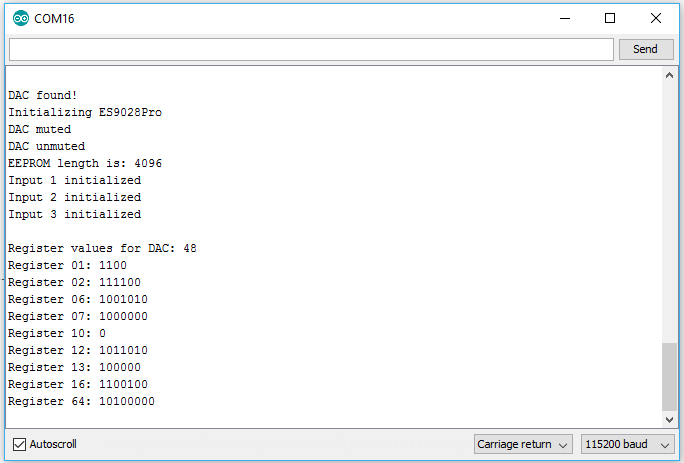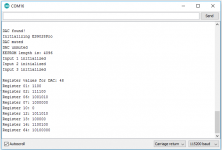Since I happened to have a burned out Buffalo III board, I experimented with mounting an ES9028Pro on it.

Since the 9028 has the same pinout as the 9018, all that needs to change on the B3 board is:
1) Put a jumper on the reset pins.
2) Put in a higher current supply for the 1.2V PS. I found that with a 100MHz clock and 352.8K material current consumption is around 200mA.

I also made a new set of Trident replacement power supplies:

It turns out the I'll have to do a new design for the 1.2V power supply, since it's running pretty hot right now..
The experiment was a success. I'm controlling it with a piece of experimental code running on an Arduino and the sound is a substantial improvement over the "stock" B3.

Next step is doing a new version of my TFT HiFiDuino code that is compatible with the 9028/9038 (their digital core is exactly the same, my code has been tested on both of them and works fine).
I've posted a couple of more detailed posts on the subject on my blog, if you'd like to read "the long version" of the experiment:
Yes, I put an ES9028Pro on my Buffalo III | Dimdim's Blog
ES9028Pro power wows | Dimdim's Blog
PS. If you happen to have a Buffalo II/III/IIISE that has an old AVCC shunt regulator on it, change it for a new Trident SR or other hi-end LDO reg design ASAP. You will get a substantial SQ upgrade for very little money.

Since the 9028 has the same pinout as the 9018, all that needs to change on the B3 board is:
1) Put a jumper on the reset pins.
2) Put in a higher current supply for the 1.2V PS. I found that with a 100MHz clock and 352.8K material current consumption is around 200mA.

I also made a new set of Trident replacement power supplies:

It turns out the I'll have to do a new design for the 1.2V power supply, since it's running pretty hot right now..
The experiment was a success. I'm controlling it with a piece of experimental code running on an Arduino and the sound is a substantial improvement over the "stock" B3.
Next step is doing a new version of my TFT HiFiDuino code that is compatible with the 9028/9038 (their digital core is exactly the same, my code has been tested on both of them and works fine).
I've posted a couple of more detailed posts on the subject on my blog, if you'd like to read "the long version" of the experiment:
Yes, I put an ES9028Pro on my Buffalo III | Dimdim's Blog
ES9028Pro power wows | Dimdim's Blog
PS. If you happen to have a Buffalo II/III/IIISE that has an old AVCC shunt regulator on it, change it for a new Trident SR or other hi-end LDO reg design ASAP. You will get a substantial SQ upgrade for very little money.
Attachments
great work Dimdim.
will you be writing code for es9028 for your display.
I have got a DIYINHK es9038pro dac kit would love to have a display and be able to control my dac but cant get my head around writing arduno code.
I have got a saismart 3.2" display,mega 2560 & TFT shield kit but have only managed to get a couple of demos sketches working on it.
will the code for es9028 be the same as for es9038.
I had the DIYINHK AK4495 dack kit & ES9018K2M kit but was unable to get the arduino codes to load from hifiduino.
Thanks for any advice or help you can give.
will you be writing code for es9028 for your display.
I have got a DIYINHK es9038pro dac kit would love to have a display and be able to control my dac but cant get my head around writing arduno code.
I have got a saismart 3.2" display,mega 2560 & TFT shield kit but have only managed to get a couple of demos sketches working on it.
will the code for es9028 be the same as for es9038.
I had the DIYINHK AK4495 dack kit & ES9018K2M kit but was unable to get the arduino codes to load from hifiduino.
Thanks for any advice or help you can give.
Looking good Dimdim.
I did a similar conversion on a dead Buffalo III but had problems with the
thermal pad on the ESS chip touching the +Ve vias under the chip.
Did you make a provision for this ?
I did a similar conversion on a dead Buffalo III but had problems with the
thermal pad on the ESS chip touching the +Ve vias under the chip.
Did you make a provision for this ?
great work Dimdim.
will you be writing code for es9028 for your display.
I have got a DIYINHK es9038pro dac kit would love to have a display and be able to control my dac but cant get my head around writing arduno code.
I have got a saismart 3.2" display,mega 2560 & TFT shield kit but have only managed to get a couple of demos sketches working on it.
will the code for es9028 be the same as for es9038.
I had the DIYINHK AK4495 dack kit & ES9018K2M kit but was unable to get the arduino codes to load from hifiduino.
Thanks for any advice or help you can give.
Yes, I've started work on 9028/9038 support for my arduino tft project. Essentially what I'm doing is a major rewrite of the code. When I'm done with it it will bear little resemblance to the current TFT HiFiDuino code.
Yes, the code for the 9028 is 100% the same as for the 9038. I've tested both chips.
The requirements will be the ones that are applicable to the current TFT HiFiDuino code.
Keep in mind that if you have the DIYINHK 9038 board and are running it without software control, you are listening to a small part of the board's performance (since it is running in multichannel mode). You'll get a very nice bump in SQ when you switch to software control, plus filter selection, etc.
Looking good Dimdim.
I did a similar conversion on a dead Buffalo III but had problems with the
thermal pad on the ESS chip touching the +Ve vias under the chip.
Did you make a provision for this ?
The 9028 does not have a thermal pad, so no prob.
If I were to try putting on a 9038, I'd put some kapton tape on the bottom of the chip and a big heatsink on top.
The 9028 does not have a thermal pad, so no prob.
If I were to try putting on a 9038, I'd put some kapton tape on the bottom of the chip and a big heatsink on top.
The ES9028PRO's I've been using have a thermal pad. Are these newer chips ?
cheers
That's interesting. The chips I got do not. Looking at their datasheet, it appears that they should. I'm not sure what's happened here. I'll get in touch with my supplier.
That's interesting. The chips I got do not. Looking at their datasheet, it appears that they should. I'm not sure what's happened here. I'll get in touch with my supplier.
Where did you purchase them from ?
cheers
The only place I could at the time - a seller on Ebay. The chips worked the way they should so I didn't really pay attention to the missing thermal pad.
Bravo DimDim !
Is the improvment a big step with the new chip ?
Should be very good with your Kali hat and the comming Kali II or the isolator hat of Ian in between 🙂
Is the improvment a big step with the new chip ?
Should be very good with your Kali hat and the comming Kali II or the isolator hat of Ian in between 🙂
The improvement from 9018 to 9028 is substantial, as long as the rest of the system is transparent enough.
But the bigger improvement came from replacing the "stock" TPA AVCC module with the LT3042-based one.
I haven't yet managed to try out Kali in this setup but I will.. Plus I'm also waiting for Ian's MC FIFO.. 🙂
But the bigger improvement came from replacing the "stock" TPA AVCC module with the LT3042-based one.
I haven't yet managed to try out Kali in this setup but I will.. Plus I'm also waiting for Ian's MC FIFO.. 🙂
yep, I ask myself how could be such a stuff with a OCXO MCL clock board (I think about the Andrea Mori's) : just have a doubt about I2S connectivity of the FIFO ?! (lack of 3 uf-l outputs plugs for the I2S = just a flat cable towards the MC clock board?... I have asked Ian in his thread) : speedy signals and conectivity and matched impedance, return signal path and shielding is impedance as you know (uf-l wires for instance)
I'm guessing Ian is convinced that the reclocking that is done on the MC Clock board takes care of any degradation of the signal on its trip from the MC FIFO to the MC Clock.
I'm guessing to give options regarding the clock boards. I'm sure Ian knows better and will reply in the proper thread. 🙂
yes, I asked (though no answer yet) ! Anyway, a diyer could make a flat cable to i2S plug adapter (joke of course !); but the goal is always also to reduce the EMI surface and exposition for RF signals 😉
Anyway it's off topic as you point out, sorry for that !
Liked a lot the air gun job 🙂

Anyway it's off topic as you point out, sorry for that !
Liked a lot the air gun job 🙂

Yes, I've started work on 9028/9038 support for my arduino tft project. Essentially what I'm doing is a major rewrite of the code. When I'm done with it it will bear little resemblance to the current TFT HiFiDuino code.
Yes, the code for the 9028 is 100% the same as for the 9038. I've tested both chips.
The requirements will be the ones that are applicable to the current TFT HiFiDuino code.
Keep in mind that if you have the DIYINHK 9038 board and are running it without software control, you are listening to a small part of the board's performance (since it is running in multichannel mode). You'll get a very nice bump in SQ when you switch to software control, plus filter selection, etc.
- Home
- Source & Line
- Digital Line Level
- Buffalo III upgraded with ES9028Pro

